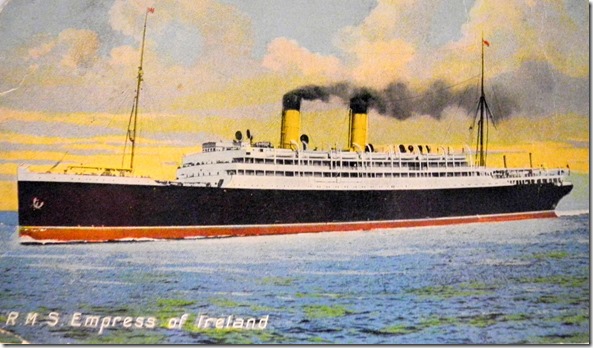Postcard of the Empress from the collection of the George Scott Railton Heritage Centre of The Salvation Army
Some historians refer to the sinking of the Empress of Ireland in the St. Lawrence River as Canada’s Titanic. The parallels to the Titanic are appropriate, as 1012 people lost their lives on the Empress during the early-morning hours of May 29, 1914. On the Titanic, 807 passengers drowned—the Empress’ death toll was 840 passengers. The final number of those who lost their lives on the Titanic was greater as more of its crew perished.
The question sometimes asked is—why is the sinking of the Empress so relatively unknown? By contrast, almost everyone is familiar with the story of the Titanic. There are several reasons for this, but none provides a satisfactory explanation. The Empress deserves a more prominent place in our history than it has received.
One of the reasons that the Empress fell into obscurity was that two months after it sank in the frigid waters of the St. Lawrence River, Canada entered the First World War. The latter event eclipsed the maritime disaster, pushing all other stories from the pages of the newspapers. When the war ended, four years had passed, and remembering those who had paid the supreme sacrifice in Europe became more prominent.
Some suggest that because the passenger list of the Empress did not contain the rich and famous, the public lost interest in the disaster. Whether this is true or not, it is a fact that the majority of those aboard were middle-class citizens or those who earned their living through manual labour. The first-class cabins of the ship were sparsely occupied.
Perhaps another reason that the Empress has not captured the imagination of the world at large is that it plunged to the bottom in a mere fourteen minutes, after a Norwegian collier, the Storstad, rammed into its starboard side. The event did not readily allow authors or filmmakers much opportunity to create imaginary heroes and romantic scenes compared to the Titanic, which took several hours to sink to its watery grave. There was no time aboard the Empress, as illustrated by the fact that the crew managed to lower only four of the ship’s forty lifeboats into the water. When the Storstad struck the Empress, the collision killed or maimed many passengers, while trapping scores of others below deck. Many perished before the ship sank.
I find it strange that some authors consider a tragedy that begins and ends within fourteen minutes as lacking literary appeal. I believe that the story of the Empress is intensely dramatic. The heartrending catastrophe deserves a more prominent place in our history.
The above quote is from the recently published novel that includes the sinking of the Empress, “When the Trumpet Sounds.”
Photo of the funeral march on Toronto’s Yonge Street in 1914. Flatbed wagons pulled by horses transported the coffins to Mt. Pleasant Cemetery. Photo from George Scott Railton Heritage Centre of The Salvation Army.
“When the Trumpet Sounds” is the dramatic tale of a British family that immigrated to Canada in the first decade of the 20th century. The story chronicles their joys and sorrows in their adopted land as they mingle with diverse and humorous characters in the Earlscourt District of Toronto. The family’s oldest son is a mischievous lad, often involved in fist-fights. Eventually, he trades his fists for a cornet, joins a Salvation Army Band and as he matures, becomes its star player. When the band travels to England to participate in an international gathering, events sweep the young man and members of his family along a fateful path that leads to the decks of the Empress of Ireland. The story climaxes with the sinking of the magnificent ocean liner in the icy waters of the St. Lawrence River in the early-morning hours of May 29, 1914.
Though this is not a religious book, it explores many spiritual ideas. Why would God allow such a tragedy to occur? Where was God when the trapped passengers on the ship prayed for help? How does a mother explain the tragedy to her young children and answer their questions as to why their loved ones will never return home?
The characters in the story are fictional, but much of the information is based on real people. The author had access to the files, photos and letters of a family that lost a loved one on the ship. The details uncovered during the research add a degree of realism to the story that would have otherwise been impossible. The book includes descriptions of early-day life in Toronto, accompanied by over 70 archival photographs of the city in that era. The band that travels to England is based on the true story of the Canadian Staff Band, which lost most of its members on the Empress in 1914.
“When the Trumpet Sounds” is available in an electronic edition for e-readers on Amazon.com and the Chapters/Indigo web sites, at a cost of $7.99. It is over 400 pages and can also be ordered in soft and hardcover editions from local book stores.
To view the Home Page for this blog: https://tayloronhistory.com/
To view previous blogs about the movie houses of Toronto—old and new:
https://tayloronhistory.com/2013/10/09/links-to-toronto-old-movie-housestayloronhistory-com/
To view links to other posts placed on this blog about the history of Toronto and its heritage buildings:
https://tayloronhistory.com/2013/10/08/links-to-historic-architecture-of-torontotayloronhistory-com/


